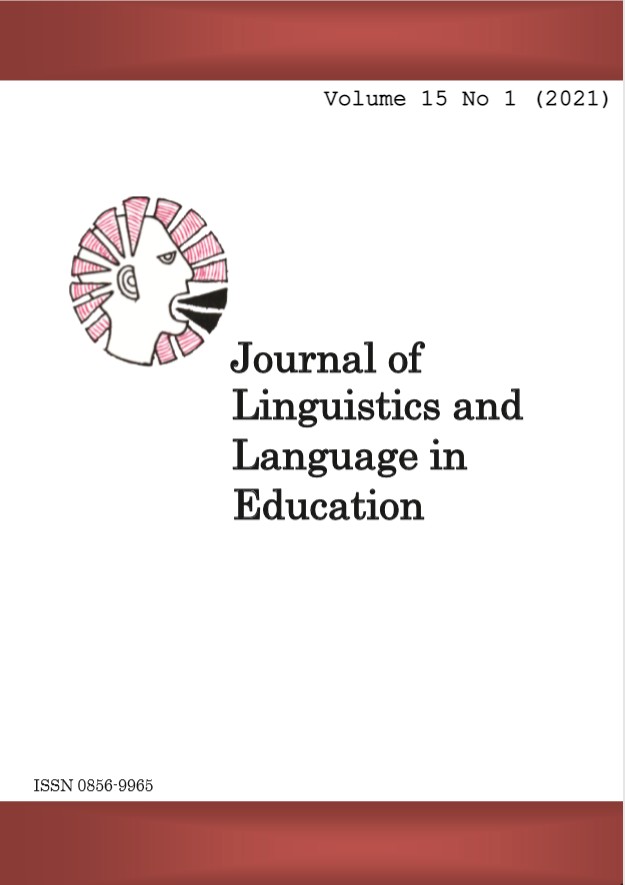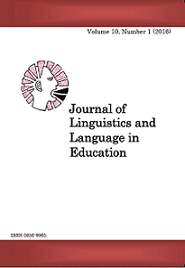Je, Uamuzi wa Kutumia Kiswahili Mahakamani Unatosha Kuleta Haki?
Abstract
Ikisiri
Makala haya ni mwitikio kwa Serikali ya Jamhuri ya Muungano wa Tanzania
kuonyesha kukijali zaidi Kiswahili na hatimaye Bunge kupitisha Mswada wa
Marekebisho ya Sheria Mbalimbali wa Mwaka 2021 kukifanya Kiswahili kiwe
lugha ya sheria na maswala yote yahusianayo na utoaji wa haki nchini. Mbali
na kupongeza upandishaji ngazi Kiswahili, makala haya hujaribu kusema
kwamba kukipandisha Kiswahili peke yake hakutapunguza ugumu wa lugha
ya sheria, na hakutatufikisha kwenye hatua ya muhimu zaidi, mgawanyo sawa
wa rasilimali lugha kati ya wakili na shahidi wakati wa mahojiano-bomozi.
Makala haya yanapendekeza mapitio ya tafsiri zilizokwishafanywa kwa
kuzingatia kwamba tafsiri za kisheria ni tofauti na nyinginezo; ianzishwe
kampeni ya lugha rahisi ya kisheria kwenye makala yote ya kisheria; itafutwe
njia ya kulainisha mahusiano kati ya sheria, haki na jamii au umma wa
Watanzania. Mwisho, makala haya hupendekeza mfumo wa sheria wa
advesaria utazamwe karibu pamoja na ule wa inkwizitoria ili kuona jinsi
inavyoweza kupatikana njia nzuri ya kutoa au kuchukua ushahidi ambayo
itazingatia mgawanyo wa rasilimali lugha.
Dhana za msingi: Advesaria, haki, inkwizitoria, Kiswahili, mahakama, sheria,
Tanzania
Abstract
This paper is a follow up to the Government of Tanzania ' s
recognition of Kiswahili and the ensuing Written Laws
Miscellaneous Amendment Act of 2021 to declare Kiswahili as the
language of laws in the country and the language to be used in
administration and the dispensation of justice. While acknowledging
the importance of the declaration, this paper argues that this
declaration alone will not make legal language any less difficult, and
will not get us to the equitable distribution of discourse resources
between councel and witnesses at cross-examination, which is a more
pressing problem. The paper suggests a review of the legal
translation of the already ' translated ' documents, mounting a serious
plain legal language campaign for the judiciary; making the relations
between the law, justice and the Tanzanian public more cordial; and
lastly, the paper suggests a closer look at the Adversarial Judicial
System together with some elements of the Inquisitorial Judicial
System to bring the equitable distribution of discourse resources
during the evidence stage.
References
Beach, W. (1985). Temporal Density in Courtroom Interaction:
Constraints on the Recovery of Past Events in Legal Discourse.
Communication Monographs, 52: 01 €“19.
Bentham, J. (1838). The Works of Jeremy Bentham, ed. J. Bowring.
Edinburgh: William Tait.
Bogoch, B. (2000). Discourse Dilemmas and Courtroom Control: the
Talk of Trial Judges. Law & Social Inquiry, 25(1): 227 €“247.
Bourdieu, P. (1987). The Force of Law: Toward a Sociology of the
Juridical Field. The Hastings Law Journal, 38: 805 €“853.
| Je, Uamuzi wa Kutumia Kiswahili Mahakamani Unatosha Kuleta Haki?
Cavagnoli, S. & Wölk, J. (1997). Einfuhrung in die Italienische
Reschssprache-Introduzione all ' italiano Giuridico.
Munich/Vienna/Bern: Bern/Manz/Stampf.
Danet, B. (1980). Language in the Legal Process. Law & Society
Review, 14: 445 €“564.
Duarte i Montserrat, C. (1993). Llengua i Adminiustraci ' o.
Barcelona: Columna Edicions.
Duarte i Montserrat, C. & Martinez, A. (1995). El Lenguaje Juridico.
Buenos Aires: A-Z editora.
Dunstan, K. (1980). Context for Coercion: Analyzing Properties of
Courtroom "Questions". British Journal of Law and Society,
(1): 61 €“77.
Freedgood, L. (2002). Voicing the Evidence: The Pragmatic Power of
Interpreters in Trial Testimony. A PhD Thesis, Boston
University.
Fröhlich, L. (2014). Legal Translation: A Study of Rogatory Letters
and its Implications. Language and Law, 1(2): 117 €“119.
Giampieri, P. (2016). Is the European Legal English Legalese-Free?
Italian Journal of Public Law, 8(2): 424 €“440.
Gibbons, J. (2003). Forensic Linguistics: An Introduction to
Language in the Justice System. Cornwall: Blackwell.
Goodman, G. S., Tobey, A. E., Batterman-Faunce, J. M., Orcutt, H.,
Thomas, S., Shapiro, C. & Sachsenmaier, T. (1998). Face-to-face
Confrontation: Effects of Closed-circuit Technology on
Children ' s Eyewitness Testimony and Jurors ' Decisions. Law
and Human Behavior, 22(2): 165 €“203.
Gowers, E. (1948). Plain Words. London: Her Majesty ' s Stationery
Office.
Gowers, E. (1954). The Complete Plain Words. London: Her
Majesty ' s Stationery Office.
Journal of Linguistics and Language in Education Volume 15, Number 1 (2021) | 43
Gunnarsson, B. L. (1984). Functional Comprehensibility of
Legislative Texts: Experiments with a Swedish Act of
Parliament. Text, 4(1 €“3): 71 €“105.
Hahn, P. & Clayton, S. (1996). The Effects of Attorney Presentation
Style, Attorney Gender and Juror Gender on Juror Decisions.
Law and Human Behavior, 20: 533 €“554.
Hale, S. & Gibbons, J. (1999). Varying Realities Patterned Changes
in the Interpreter ' s Pepresentation of Courtroom and External
Realities. Applied Linguistics, 20(2): 203 €“220.
Hayes, S. (1993). People with an Intellectual Disability and the
Criminal Justice System: Appearances before Local Courts (4).
Sidney: New South Wales Law Reform Commission.
Hazard, G. C. (1991). The Future of Legal Ethics. The Yale Law
Journal, 100(5): 1239 €“1280.
Ismail, J. (2020). Mchango wa Tasinia ya Sheria katika Ukuzaji na
Uenezaji wa Kiswahili Tanzania: Mifano kutoka Mahakama ya
Tanzania na Taasisi za Wadau wa Sheria. East African Journal
of Swahili Studies, 2(2): 11 €“22.
Jacquemet, M. (1996). Credibility in Court: Communicative Practices
in the Camorra Trial. Cambridge: Cambridge University Press.
Kenny, S. (1999). Maintaining Public Confidence in the Judiciary: A
Precarious Equilibrium. Monash University Law Review, 25(2):
Keya, A. (2013). A Critical Discourse Analysis of Cross-Examination
at the High Court of Tanzania in Dar es Salaam. PhD
Dissertation, University of Dar es Salaam.
Keya, A. (2016). "Nani Aliamua?" Sera ya Lugha na Kitokeacho
Mahakamani Tanzania. Journal of Linguistics and Language in
Education, 10(1): 20 €“36.
Keya, A. (2017a). The Counsel-Witness Battle of Identities on Cross-
Examination at the High Court of Tanzania in Dar es Salaam.
Journal of Linguistics and Language in Education, 11(1): 1 €“18.
| Je, Uamuzi wa Kutumia Kiswahili Mahakamani Unatosha Kuleta Haki?
Keya, A. (2017b). How Some Witnesses Have Vied for Floor Control
in Tanzanian Higher Courts.Tanzanian Journal of Population
Studies and Development, 24(1&2): 94 €“107.
Kirchheimer, O. (1969). Political Justice €“ The Use of Legal
Procedure for Political Ends. Princeton, NJ: Princeton
University Press.
Konradi, A. (1996). Preparing to Testify: Rape Survivors Negotiating
the Criminal Justice process. Gender and Society, 10(4): 404 €“
Luchjenbroers, J. (1991). Discourse Dynamics in the Courtroom:
Some Methodological Points of Description. La Trobe
University Working Papers in Linguistics, (4): 85 €“109.
Magenau K. S. (2003). Jury Duty: Competing Legal Ideologies and
the Interactional Negotiation of Authority in Jury Deliberation.
PhD Thesis, Georgetown University.
Maley, Y. (1994). The Language of the Law. In J. Gibbons (ed.).
Language and the Law. London: Longman.
Matoesian, G. M. (1993). Reproducing Rape: Domination through
Talk in the Courtroom. Chicago: Chicago University Press.
Melinkoff, D. (1963). Language of the Law. Boston, M.A: Little,
Brown.
Moreno, F. J. (2016). V- Teaching the Use of ad hoc Corpora.
Language and Law/Linguagem e Direito, 3(1), 100 €“119.
Murphy, P. (2000). Murphy on Evidence (7th Edition). London:
Blackstone Press Limited.
Okawara, M. H. (2004). Legal Japanese Viewed the Unfair
Competition Prevention Law. In J. Gibbons, V. Prakasham and
K.V. Tirumalesh (eds.). Justice and Language. Delhi: Longman
Orient.
Parriag, A. (2001). An Analysis of Courtroom Dynamics of Sexual
Assault Trials. PhD Thesis, Carleton University.
Journal of Linguistics and Language in Education Volume 15, Number 1 (2021) | 45
Penman, R. (1987). Discourse in Courts: Cooperation, Coercion and
Coherence. Discourse Processes, 10: 201 €“218.
Penman, R. (1992). Plain English: Wrong Solution to an Important
Problem. Australian Journal of Communication, 19(3): 1 €“18.
Rawls, J. (2011). A Theory of Justice. New Delhi: Universal Law
Publishing.
Renton, D. (1975). The Preparation of Legislation: Report of a
committee appointed by the Lord President of the Council.
London: Her Majesty ' s Stationery Office.
Rigney, A. C. (1999). Questioning in Interpreted Testimony. Forensic
Linguistics, 6(1): 1350 €“1771.
Shivji, I., Majamba, H., Makaramba, R., & Peter, C. (2004).
Constitutional and Legal System of Tanzania: A Civics
Sourcebook. Dar es Salaam: Mkuki na Nyota Publishers Ltd.
Wahn, P. & Clayton, S. D. (1996). The Effects of Attorney
Presentation Style, Attorney Gender and Juror Gender on
Juror Decisions. Law and Human Behavior, 20(5): 533 €“554.
Walker, A. G. (1987). Linguistic Manipulation, Power and the Legal
Setting. In L. Kedar (ed.) Power through Discourse. New
Jersey: Ablex.
Watson, A. (2007). Law and Society. In J. W. Cairns and P. du
Plessis (eds.) Beyond Dogmatics: Law and Society in the Roman
World. Edinburgh: the Edinburgh Law Review Trust and the
Contributors.
Woodbury, H. (1984). The Strategic Use of Questions in Court.
Semiotica, 48(3/4): 197 €“228.
Zdenkowski, G. (2007). Magistrates ' Courts and Public Confidence.
Canbera: NSW Local Courts.
Zipursky, B. C. (2005). Philosophy of Tort Law. In M. P. Golding and
W. A. Edmundson (eds.). The Blackwell Guide to the
Philosophy of Law and Legal Theory. Oxford: Blackwell
Publishing.
Downloads
Published
Issue
Section
License
Copyright © by Department of Foreign Languages and Linguistics, University of Dar es Salaam
All rights reserved. No part of this publication may be reproduced or transmitted in any form or by any means, electronic or mechanical, including photocopying, recording, or any information storage or retrieval system, without permission in writing from the publisher, except for short extracts in fair dealing, for research or private study, critical scholarly review or discourse with an acknowledgement.



